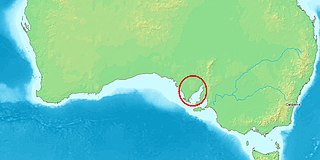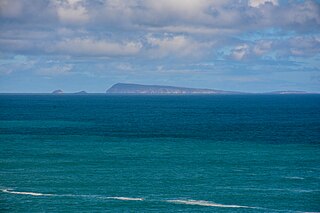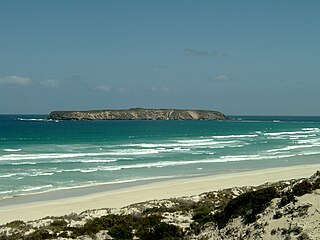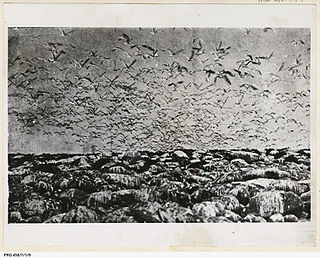
The Spencer Gulf is the westernmost and larger of two large inlets on the southern coast of Australia, in the state of South Australia, facing the Great Australian Bight. It spans from the Cape Catastrophe and Eyre Peninsula in the west to Cape Spencer and Yorke Peninsula in the east.

The Neptune Islands consist of two groups of islands located close to the entrance to Spencer Gulf in South Australia. They are well known as a venue for great white shark tourism.
Sibsey Island is an island in the Australian state of South Australia located in Spencer Gulf within the Sir Joseph Banks Group. It was discovered on 21 February 1802 by Matthew Flinders. Currently, the island is uninhabited.

Seal Bay Conservation Park is a protected area located on the south coast of Kangaroo Island in the Australian state of South Australia. It is the home of the third largest Australian sea lion colony in Australia.
Thistle Island / Noondala is in the Spencer Gulf, South Australia, some 200 kilometres (120 mi) west of Adelaide, and northwest of the Gambier Islands. The city of Port Lincoln lies to the northwest of the island. Between them, the Gambier Islands and Thistle form a chain across the mouth of the gulf between the southern tips of the Yorke and Eyre Peninsulas, sometimes referred to as the Taylor Islands group.

Wedge Island is an island in the Australian state of South Australia located within the island group known as the Gambier Islands near the entrance to Spencer Gulf. It is the largest of the Gambier Islands, covers an area of about 10 square kilometres (3.9 sq mi) and is partly privately owned.

The Sir Joseph Banks Group is an archipelago in the Australian state of South Australia located in Spencer Gulf about 20 kilometres (12 mi) off the eastern coast of the Eyre Peninsula. It consists of 21 islands of which eighteen are in the Sir Joseph Banks Group Conservation Park while the surrounding waters are in the Sir Joseph Banks Group Marine Park. It is considered to be an important seabird breeding site.
Neptune Islands Conservation Park is a protected area occupying most of the Neptune Islands in South Australia about 55 km (34 mi) south-south east of Port Lincoln. It was established in 1967 principally to protect a New Zealand fur seal breeding colony. The conservation park was subsequently expanded to include the adjoining waters in order to control and manage berleying activities used to attract great white sharks. As of 2002, the conservation park is the only place in Australia where shark cage diving to view great white sharks is legally permitted.
Williams Island is an island in the Australian state of South Australia located off the south coast of Jussieu Peninsula on Eyre Peninsula approximately 34 km (21 mi) south-east of Port Lincoln. It was named by Matthew Flinders for Robert Williams who subsequently lost his life along with seven other crew in the capsize of a cutter launched from HM Sloop Investigator to search for water on 21 February 1802. Since 2004, the island has been part of the Memory Cove Wilderness Protection Area.
Hopkins Island is an island located in Spencer Gulf off the east coast of Jussieu Peninsula on Eyre Peninsula in South Australia approximately 32 km (20 mi) south-east of Port Lincoln. It was named by Matthew Flinders in memory of John Hopkins who was one of the eight crew lost from a cutter that capsized on 21 February 1802. Since 2004, the island has been part of the Memory Cove Wilderness Protection Area.
Cape Gantheaume is a headland located on the south coast of Kangaroo Island in South Australia. It was named after Vice admiral Honoré Joseph Antoine Ganteaume (1755–1818) by the Baudin expedition to Australia during 1803. It is currently located within the protected area known as the Cape Gantheaume Wilderness Protection Area.

The Casuarina Islets, also known as The Brothers, is a pair of islands located in the Great Australian Bight immediately off the south-west coast of Kangaroo Island in South Australia approximately 96 kilometres south-west of Kingscote. The pair is currently part of the Flinders Chase National Park.

The Whidbey Isles Conservation Park is a protected area in the Australian state of South Australia which consists of seven islands located about 15 kilometres (9.3 mi) west-southwest of Coffin Bay on the lower Eyre Peninsula.

Pearson Island is an island located in the Australian state of South Australia within the Pearson Isles an island group located in the larger group known as the Investigator Group about 63 kilometres southwest by west of Cape Finniss on the west coast of Eyre Peninsula. The group was discovered and named by Matthew Flinders on 13 February 1802. The island group has enjoyed protected area status since the 1960s and since 2011, it has been part of the Investigator Group Wilderness Protection Area. Pearson Island is notable both for its colony of Pearson Island Rock wallaby and for being a destination for scientific research.

Dangerous Reef is an island and reef system located in the Spencer Gulf in the Australian state of South Australia about 32.5 kilometres (20.2 mi) east-southeast of the city, Port Lincoln. It is the southernmost member of the Sir Joseph Banks Group. It has been the site of a navigation aid since 1911. It is notable as the site of a breeding colony of Australian sea lions. The waters adjoining its shore are notable as a place to view great white sharks to the extent that it was both a popular gamefishing and shark cage diving venue during the twentieth century, and was used to film footage for the following motion pictures – Blue Water White Death and Jaws. The island has enjoyed protected area status since 1900 and it has been part of the Sir Joseph Banks Group Conservation Park since 1989.

The Australian little penguin, also called the fairy penguin, little blue penguin, or blue penguin, is a species of penguin from Australia and the Otago region of New Zealand. The species was described as Spheniscusnovaehollandiae in 1826. It was later reclassified as Eudyptulaminornovaehollandiae, a subspecies of the little penguin. After a 2016 study, Eudyptula novaehollandiae was again recognised as a distinct species.
Spilsby Island is one of the largest islands in the Sir Joseph Banks Group in Spencer Gulf, South Australia. It is privately owned, has no permanent human residents and is grazed by sheep. The island was used for the breeding of sheep by James Hunter Kerrison, then for the breeding of horses, sheep, pigs and cattle by W. E. Scruby in the early 20th century. Shearers travelled to the island to shear the sheep. The island's soil has been enriched by the deposition of guano by seabirds. Land allotments and a few shacks are concentrated along the northern coast of the island. Butterfish Bay is on the northern coast and Hawknest Bay is on the eastern coast.
Boucaut Island is a small, uninhabited island in the Sir Joseph Banks Group in South Australia's Spencer Gulf. It lies 1.2 km northeast of Spilsby Island. Seal Rock lies 250 metres southeast of Boucaut Island.

Stickney Island is an uninhabited island of the Sir Joseph Banks Group located in Spencer Gulf, South Australia.
Langton Island is a small, uninhabited island of the Sir Joseph Banks Group in Spencer Gulf, South Australia. The Island was named by Captain Matthew Flinders during his exploration of South Australia's coastline in 1802. Langton Island was named after Langton Hall in Lincolnshire. A "huge" breeding colony of Fairy terns was found on Langton Island by naturalists from the McCoy Society in 1937. Fishermen have caught whiting in nearby waters.










